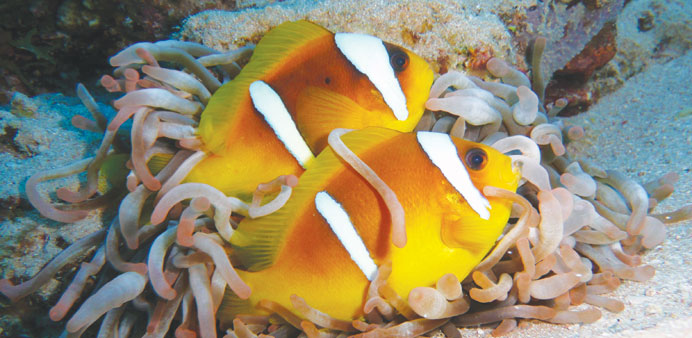The near silent or “stealth diving” is ideal for underwater photo and video shoots as it allows divers to get closer to fish and for scientific purposes apart from remarkably extending the duration of underwater stay
By Bonnie James/Deputy News Editor
Recreational diving is getting increasingly popular and hi-tech in Qatar with closed-circuit rebreathers that eliminate the large burst of noisy bubbles released from conventional scuba with each exhaled breath.
“Closed-circuit rebreathers, now the first choice of Qatar’s diving elite, have advanced hardware and software to enhance safety and enables to approach marine life much more closely with minimal disturbance,” veteran marine consultant and diving expert Khaled Zaki said.
The near silent or “stealth diving” is ideal for underwater photo and video shoots as it allows divers to get closer to fish and for scientific purposes apart from remarkably extending the duration of underwater stay.
“I can stay for up to three hours underwater while diving in most of the dive sites in Qatar with this rebreather,” explained Zaki, who hopes to dive up to 100m with the Poseidon MK6 rebreather “very soon” after some modification by its manufacturer in Sweden.
A closed-circuit rebreather weighs just eight kg, including the carbon dioxide scrubber, whereas the normal open circuit scuba weighs about 15kg or more to get the same bottom time.
“The closed-circuit rebreather is so safe and easy that even children can use it,” explained Zaki, who describes himself as “the first specialised instructor for MK6 in the region”.
One of the greatest advantages is substantially enhanced gas efficiency. Under normal circumstances, a diver uses only a little amount of oxygen from each inhaled breath, with most of the oxygen exhaled unused.
The bubbles emitted by an open-circuit scuba (self-contained underwater breathing apparatus) are oxygen and other gases that are exhaled.
The inefficiency of the open-circuit systems aggravate in proportion to the dive depth, as more gas molecules are lost with each exhaled breath because of the increased pressure.
“But, the rebreather keeps in a loop all of the exhaled breath, which is processed in a C02 scrubber and returned to the diver along with a short burst of fresh oxygen, if needed, as and when required to maintain the maximum efficiency,” Zaki said.
It is estimated that a standard scuba cylinder contains enough gas to sustain an average resting person for about 60 minutes at the surface and last 30 minutes 10m underwater, and less than 12 minutes at 40m.
“On the other hand, if the same cylinder is filled with oxygen and used to supply a closed-circuit rebreather, the diver could theoretically stay underwater for two days, irrespective of the depth, as the gas would last that long,” the expert said.
In reality, a diver with some closed-circuit rebreathers can stay at a depth of 40m for up to three hours, which is the time taken for the C02 scrubber to get saturated.
Another salient feature is decompression optimisation, a unique advantage of electronic closed-circuit rebreathers as it maintains a constant partial pressure of oxygen in the breathing gas in contrast to semi-closed rebreathers that maintain a constant amount of oxygen.
“This allows a diver to stay longer at depth without the need for decompression,” Zaki observed. Yet another edge of closed-circuit rebreather is warm, moist gas, allowing body heat to be maintained.
Advanced technology enables the rebreather to constantly monitor the levels of oxygen and carbon dioxide and partial pressure in the loop to calculate bottom time and maximum depth even with multi-level deep dives.
“One of the best features of this unit is that if at all there is a problem, the system will give visual, audio and vibration alerts allowing the diver to switch the unit to open-circuit and bail out,” Zaki said.
Though a full kit of closed-circuit rebreather with accessories could cost about QR36,500, the technology has the potential to attract more people to recreational diving, he added.

